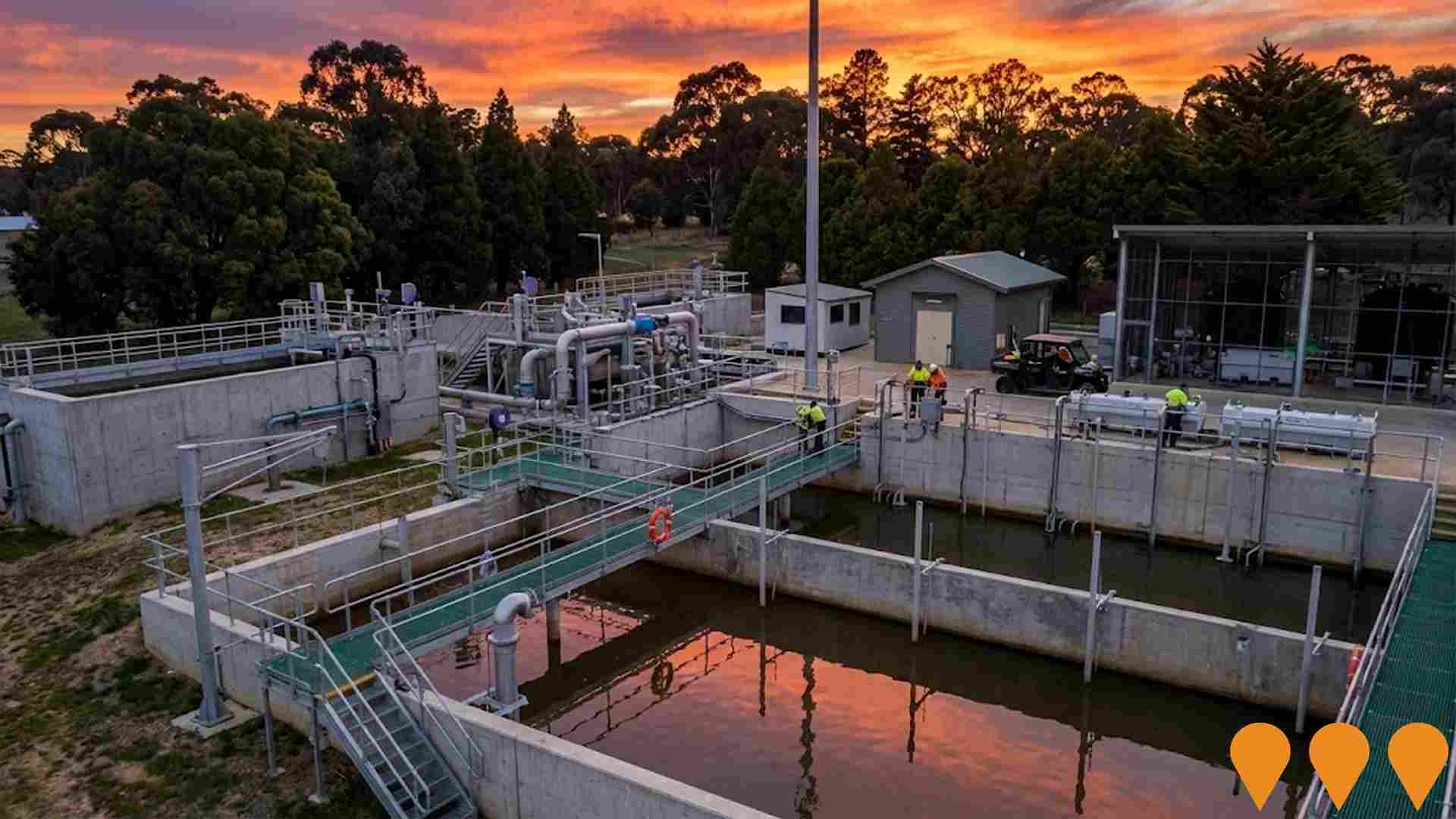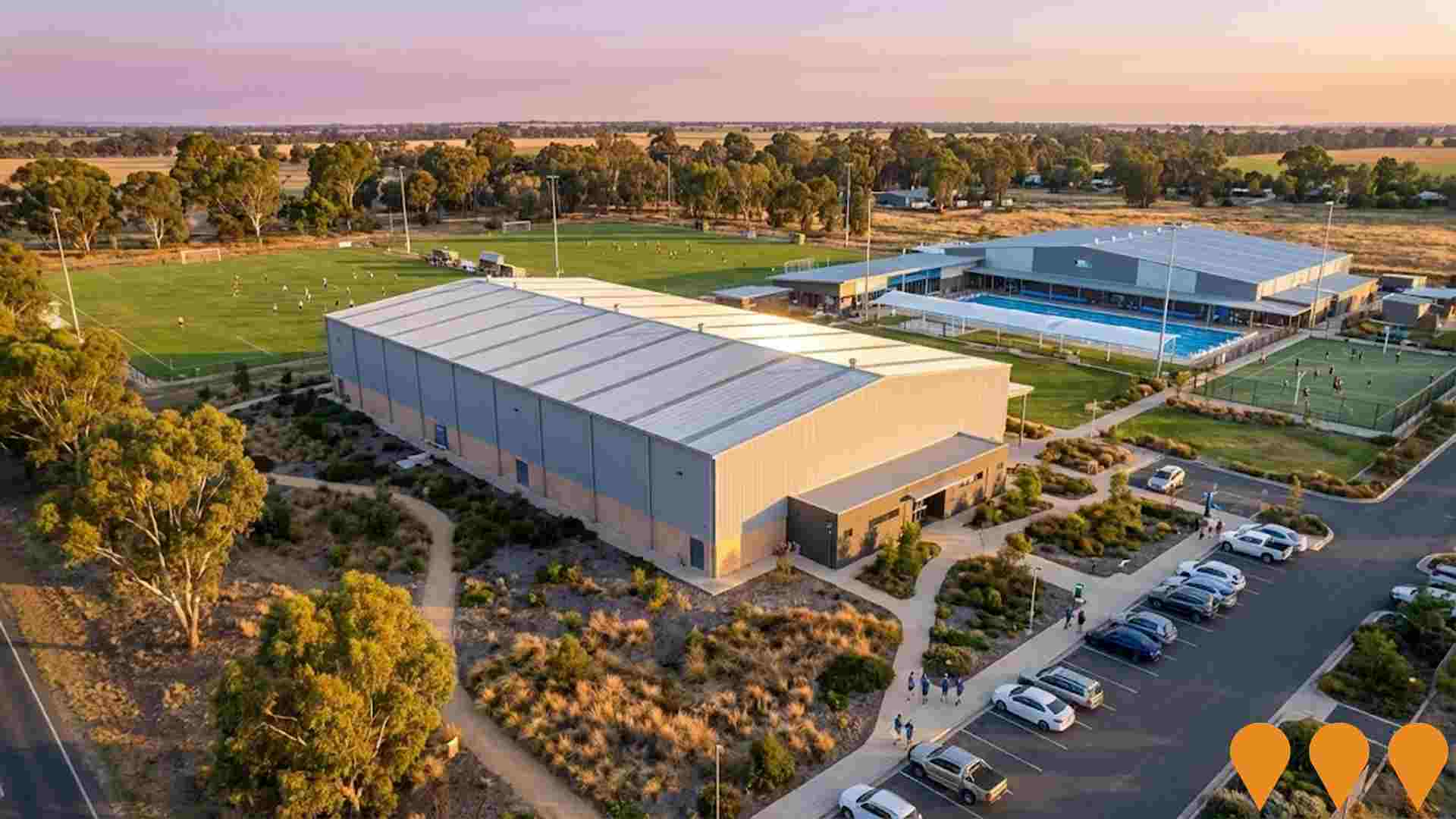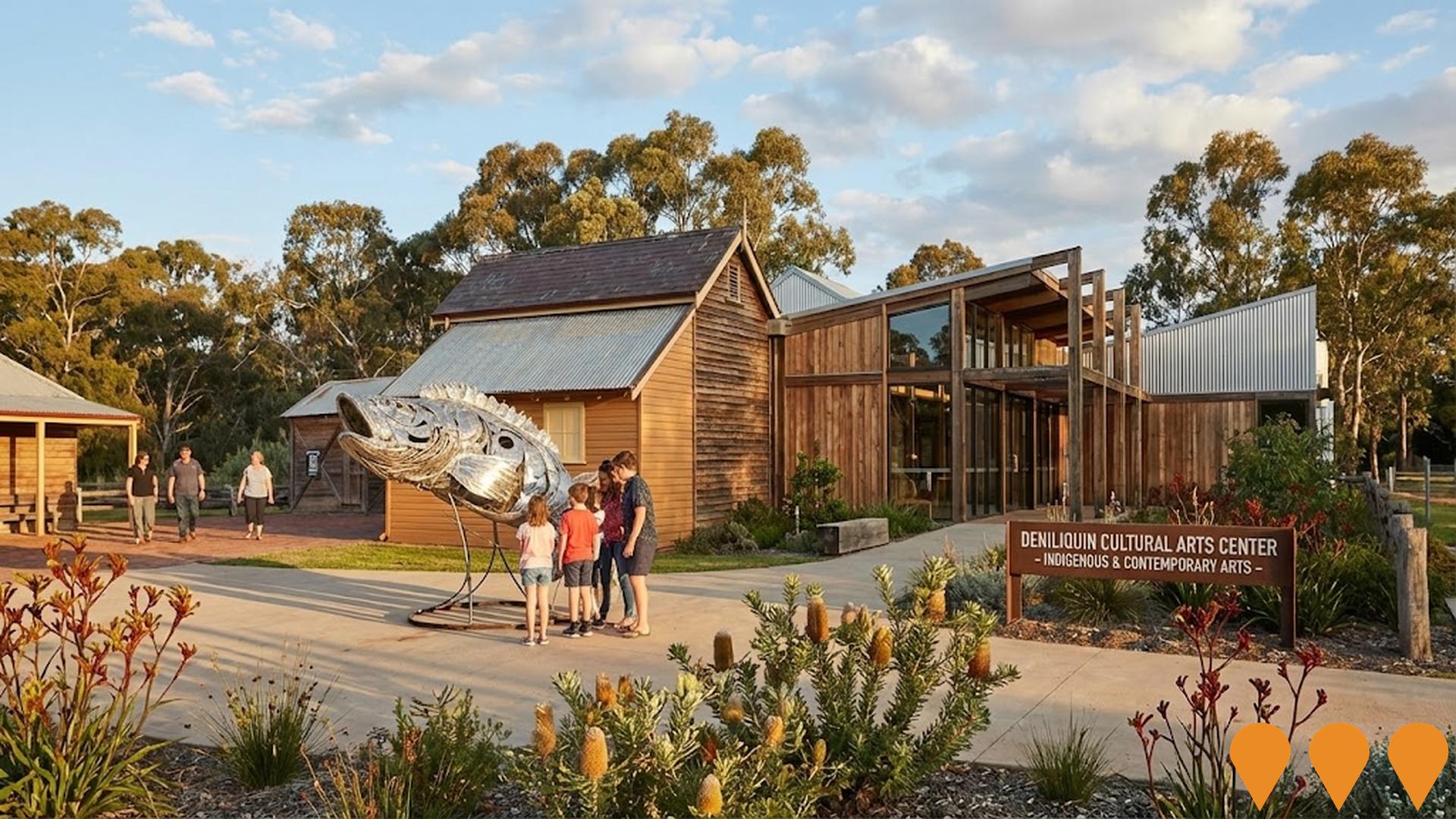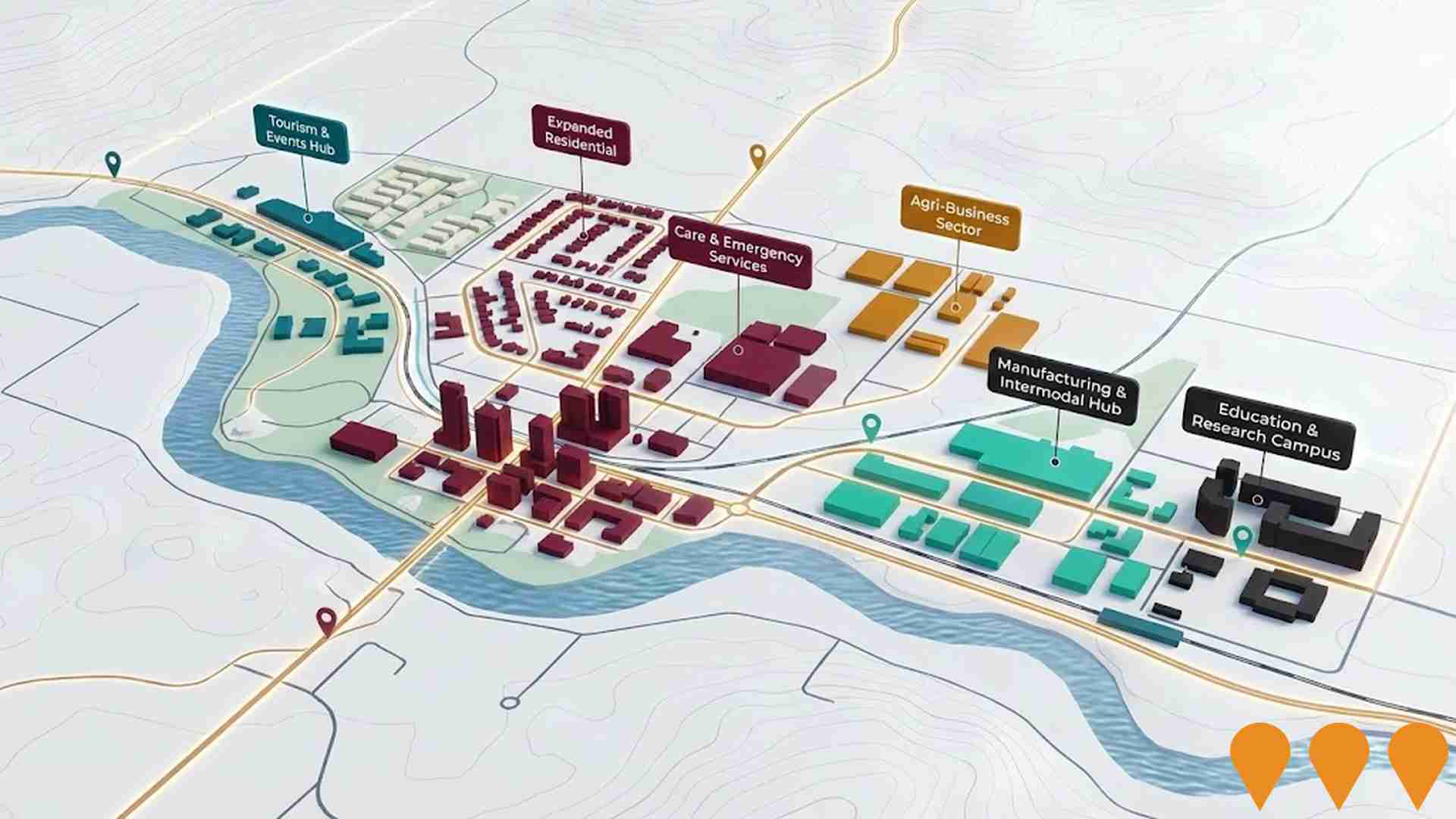Chart Color Schemes
est. as @ -- *
ABS ERP | -- people | --
2021 Census | -- people
Sales Activity
Curious about local property values? Filter the chart to assess the volume and appreciation (including resales) trends and regional comparisons, or scroll to the map below view this information at an individual property level.
Find a Recent Sale
Sales Detail
Population
Deniliquin has shown very soft population growth performance across periods assessed by AreaSearch
Based on AreaSearch's analysis, Deniliquin's population is around 7,258 as of Nov 2025. This reflects an increase of 220 people since the 2021 Census which reported a population of 7,038 people. The change was inferred from ABS estimated resident population of 7,054 in June 2024 and an additional 138 validated new addresses since the Census date. This level of population equates to a density ratio of 50 persons per square kilometer. Deniliquin's growth rate of 3.1% since census positions it within 2.0 percentage points of the non-metro area (5.1%). Overseas migration was primarily responsible for recent population gains in Deniliquin.
AreaSearch is adopting ABS/Geoscience Australia projections released in 2024 with a base year of 2022 for each SA2 area, and NSW State Government's SA2 level projections released in 2022 with a base year of 2021 for areas not covered by the former data. Growth rates by age group from these aggregations are applied to all areas for years 2032 to 2041. According to these projections, Deniliquin's population is expected to decline by 48 persons by 2041. However, specific age cohorts are anticipated to grow, led by the 75 to 84 age group which is projected to increase by 239 people.
Frequently Asked Questions - Population
Development
AreaSearch assessment of residential development drivers sees a low level of activity in Deniliquin, placing the area among the bottom 25% of areas assessed nationally
Deniliquin has seen approximately 14 new homes approved annually. Between financial years 2020-21 (FY-21) and 2025-26 (FY-25), 74 homes were approved, with an additional 7 approved in FY-26 to date. Despite population decline, the new supply has likely kept pace with demand, offering buyers good choice.
The average expected construction cost value of new homes is $433,000, higher than regional norms due to quality-focused development. In FY-26, $6.8 million in commercial development approvals have been recorded, reflecting the area's primarily residential nature. Compared to Rest of NSW, Deniliquin shows significantly reduced construction activity (64.0% below regional average per person), which generally supports stronger demand and values for established dwellings. This is also under the national average, suggesting the area's established nature and potential planning limitations. New development consists predominantly of detached houses (92.0%), with a smaller proportion of medium and high-density housing (8.0%), maintaining Deniliquin's traditional low density character focused on family homes.
The estimated population per dwelling approval is 516 people, indicating a quiet, low activity development environment. With population expected to remain stable or decline, Deniliquin should see reduced pressure on housing, potentially creating opportunities for buyers.
Frequently Asked Questions - Development
Infrastructure
Deniliquin has moderate levels of nearby infrastructure activity, ranking in the top 50% nationally
Infrastructure changes significantly influence an area's performance. AreaSearch identified 13 projects likely impacting the area. Notable projects include Deniliquin Hospital Redevelopment, Deniliquin Battery Energy Storage System (BESS), Hardinge Street Road Reconstruction Project, and Deniliquin Cultural Arts Center. The following list details those most relevant.
Professional plan users can use the search below to filter and access additional projects.
INFRASTRUCTURE SEARCH
 Denotes AI-based impression for illustrative purposes only, not to be taken as definitive under any circumstances. Please follow links and conduct other investigations from the project's source for actual imagery. Developers and project owners wishing us to use original imagery please Contact Us and we will do so.
Denotes AI-based impression for illustrative purposes only, not to be taken as definitive under any circumstances. Please follow links and conduct other investigations from the project's source for actual imagery. Developers and project owners wishing us to use original imagery please Contact Us and we will do so.
Frequently Asked Questions - Infrastructure
Merino Wind Farm and Battery
Octopus Australia is developing a 1GW onshore wind farm with integrated 400MW/800MWh battery energy storage system on a ~28,000 hectare site north of Deniliquin in the South West Renewable Energy Zone (REZ), NSW. The project is adjacent to Octopus's proposed Saltbush Wind Farm and will have capacity to power approximately 800,000 NSW homes annually once operational.
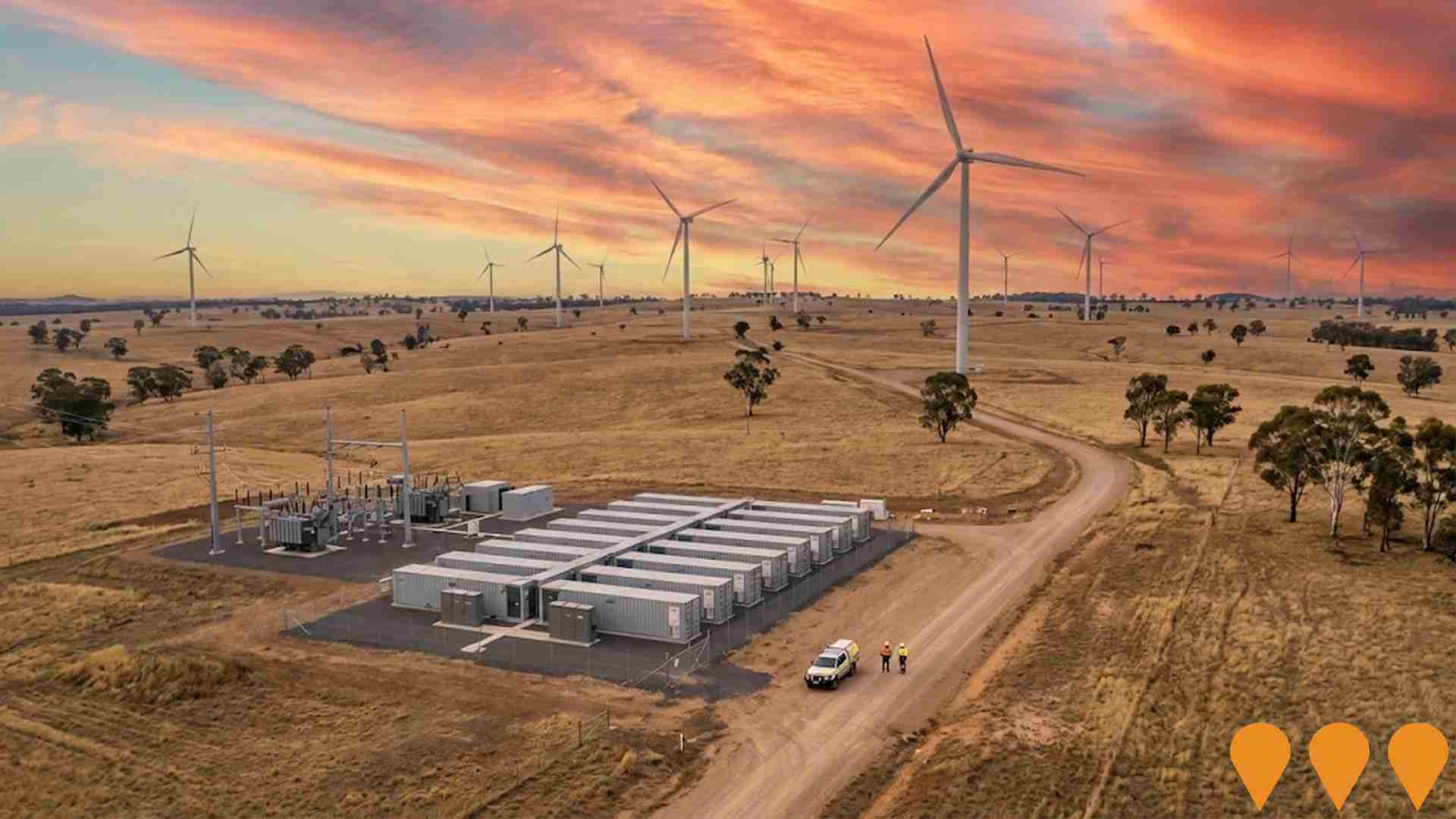
Deniliquin Inland Port
Deniliquin Inland Port is a proposed intermodal freight hub and industrial precinct at Deniliquin in the Edward River Council area. The project would expand on the existing Caruso Brothers Transport and Deni Industrial Park site to create a co located manufacturing and logistics hub that uses the Deniliquin railhead and Cobb Highway connections to move containerised rice and other agricultural products to the Port of Melbourne and wider domestic markets. It is intended to lower freight costs, attract new industry and jobs, and support long term growth of the Murray Darling agricultural region.
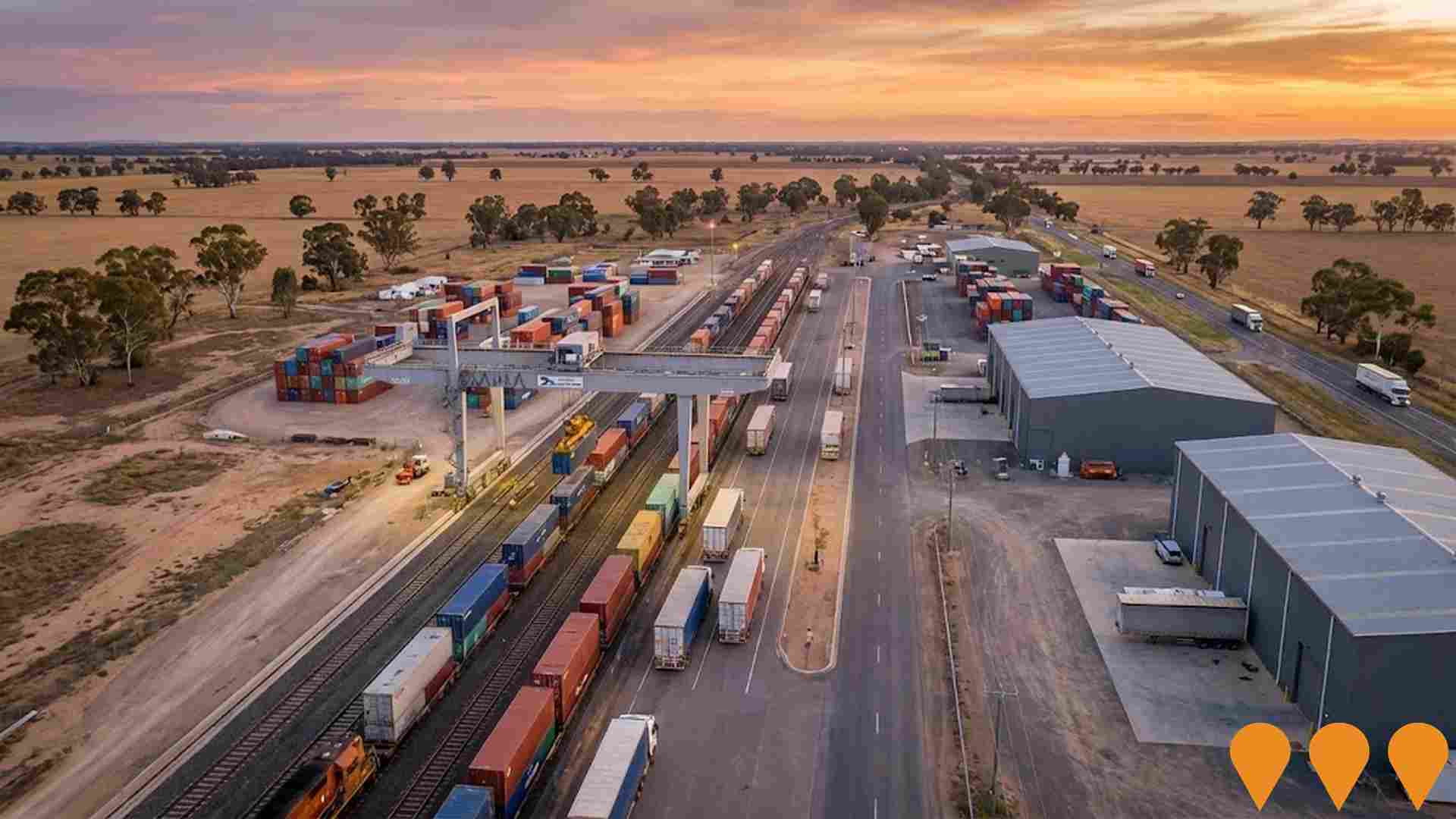
Deniliquin Solar Farm Stage 2
Proposed 600MW solar photovoltaic farm east of Deniliquin, to be developed on farmland adjacent to the existing Deniliquin Solar Farm. The project would connect into existing transmission infrastructure and materially increase renewable generation capacity in the wider South West NSW region.
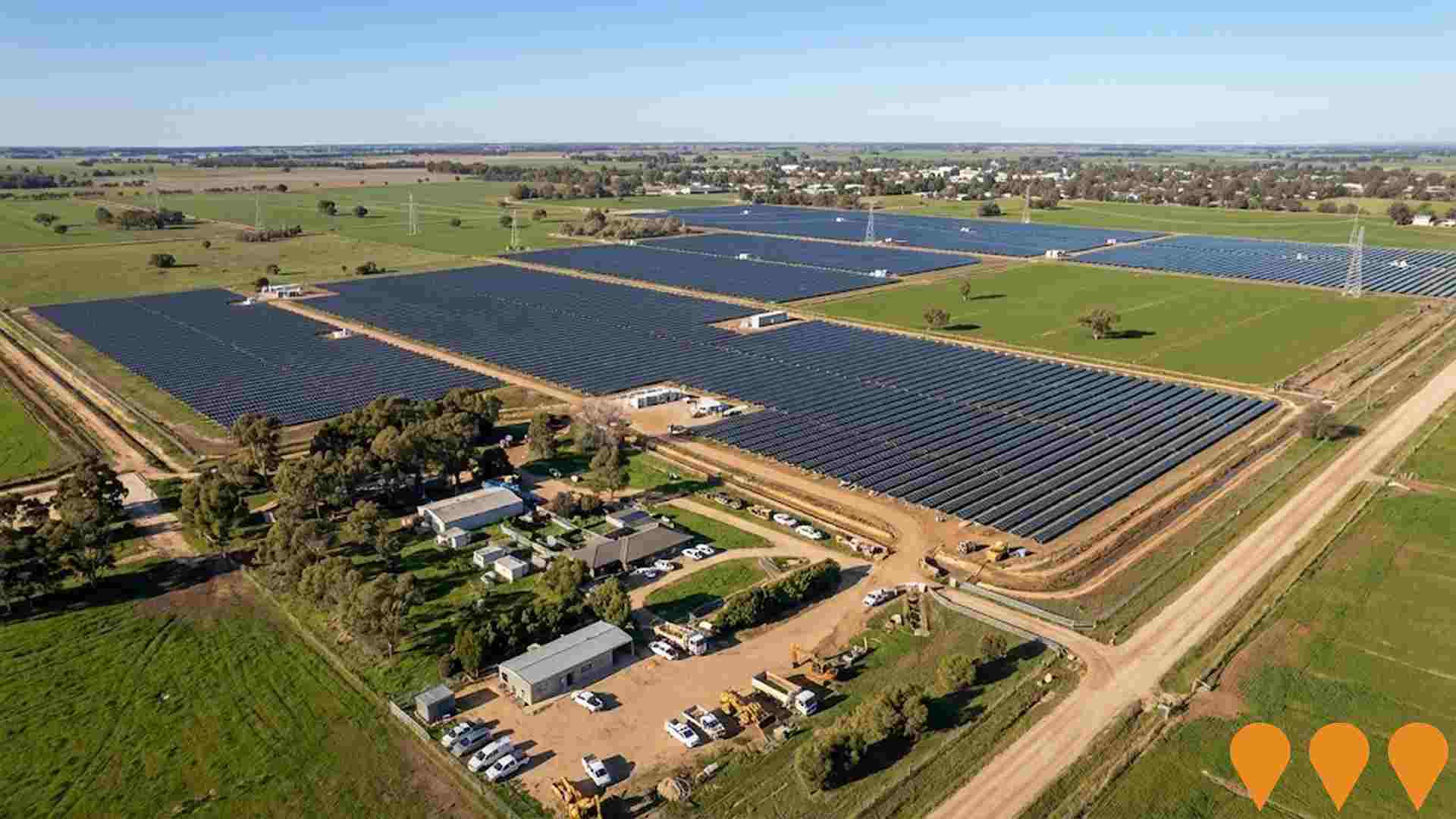
Deniliquin Industrial Estate
New and expanding industrial estate focused on Kelly Street in Deniliquin, providing serviced industrial lots and modern infrastructure to attract food processing, agricultural machinery, logistics, warehousing and related businesses. Edward River Council has delivered key road, kerb and gutter and stormwater works in the precinct and is progressively releasing industrial land in line with the Edward River Industrial Land Strategy and the Edward River 2050 Growth Strategy.
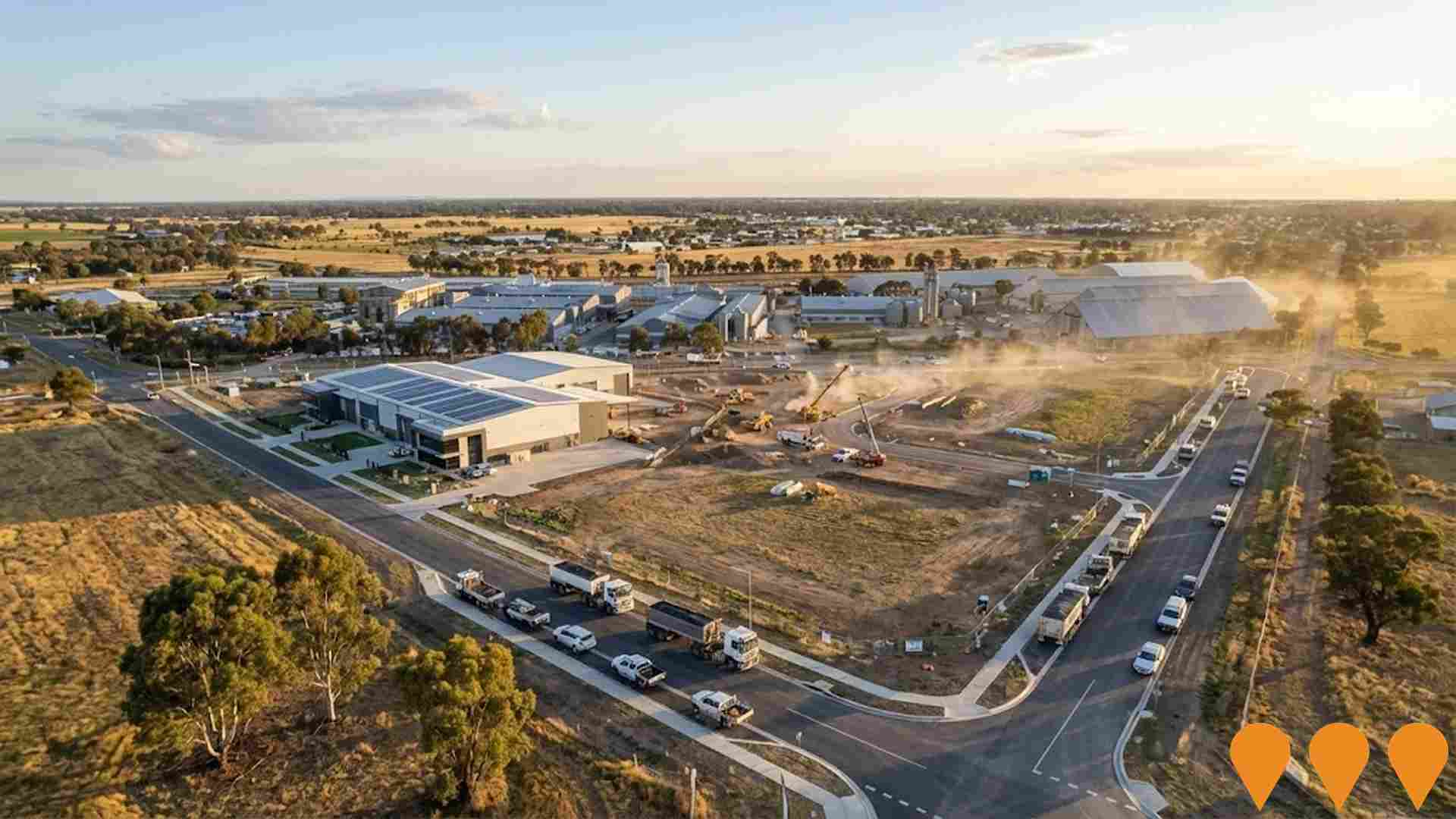
Deniliquin Battery Energy Storage System (BESS)
120MW / 480MWh lithium-ion battery energy storage system to assist the national electrical grid during peak demand and emergencies. Located 6km southeast of Deniliquin on a 7-hectare site, connecting to the 132kV Deniliquin substation.
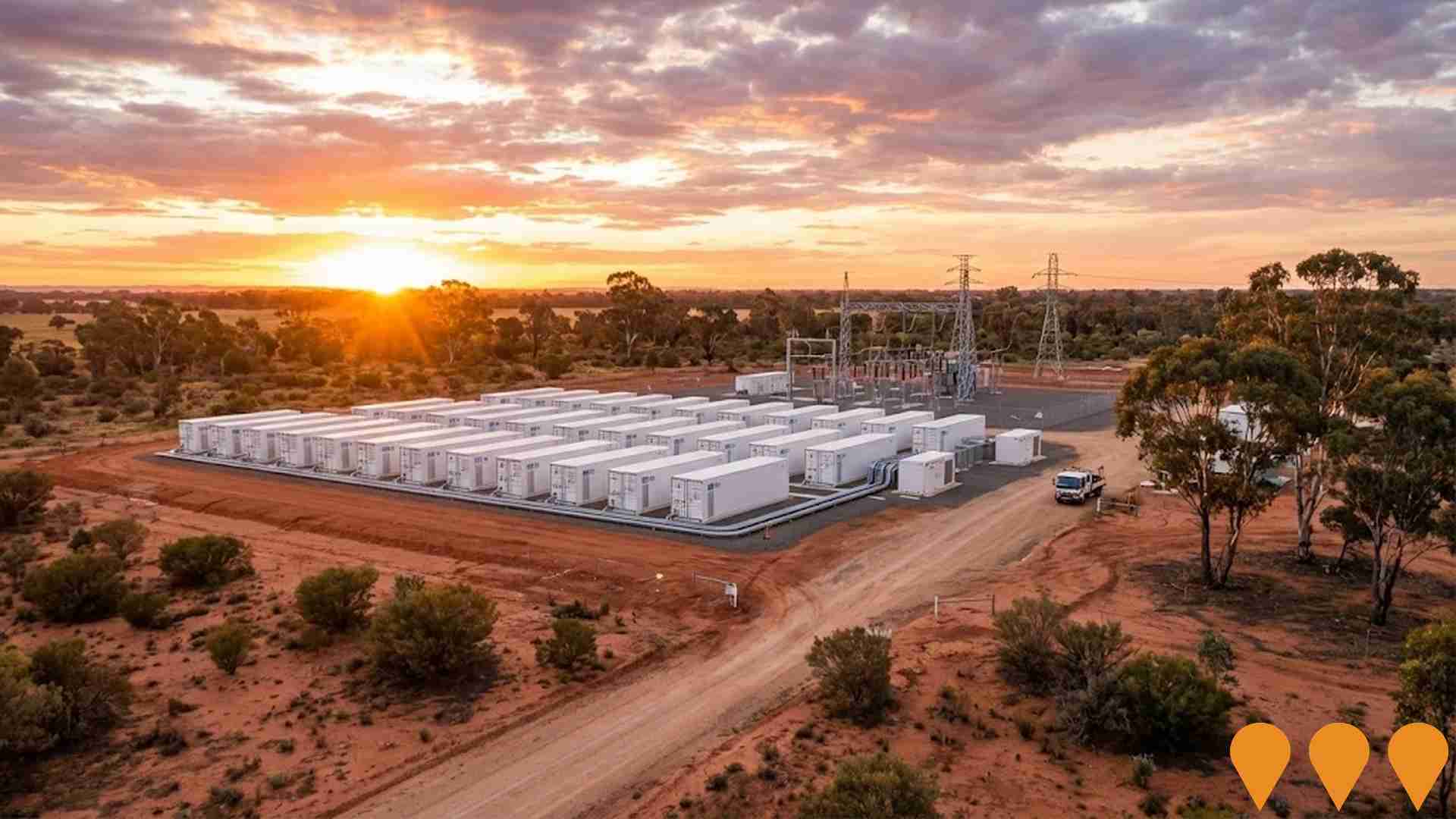
Deniliquin Agricultural Research Facility
State-of-the-art agricultural research center focusing on drought-resistant crops, sustainable farming practices, and climate adaptation strategies. Partnership between NSW DPI and Charles Sturt University.
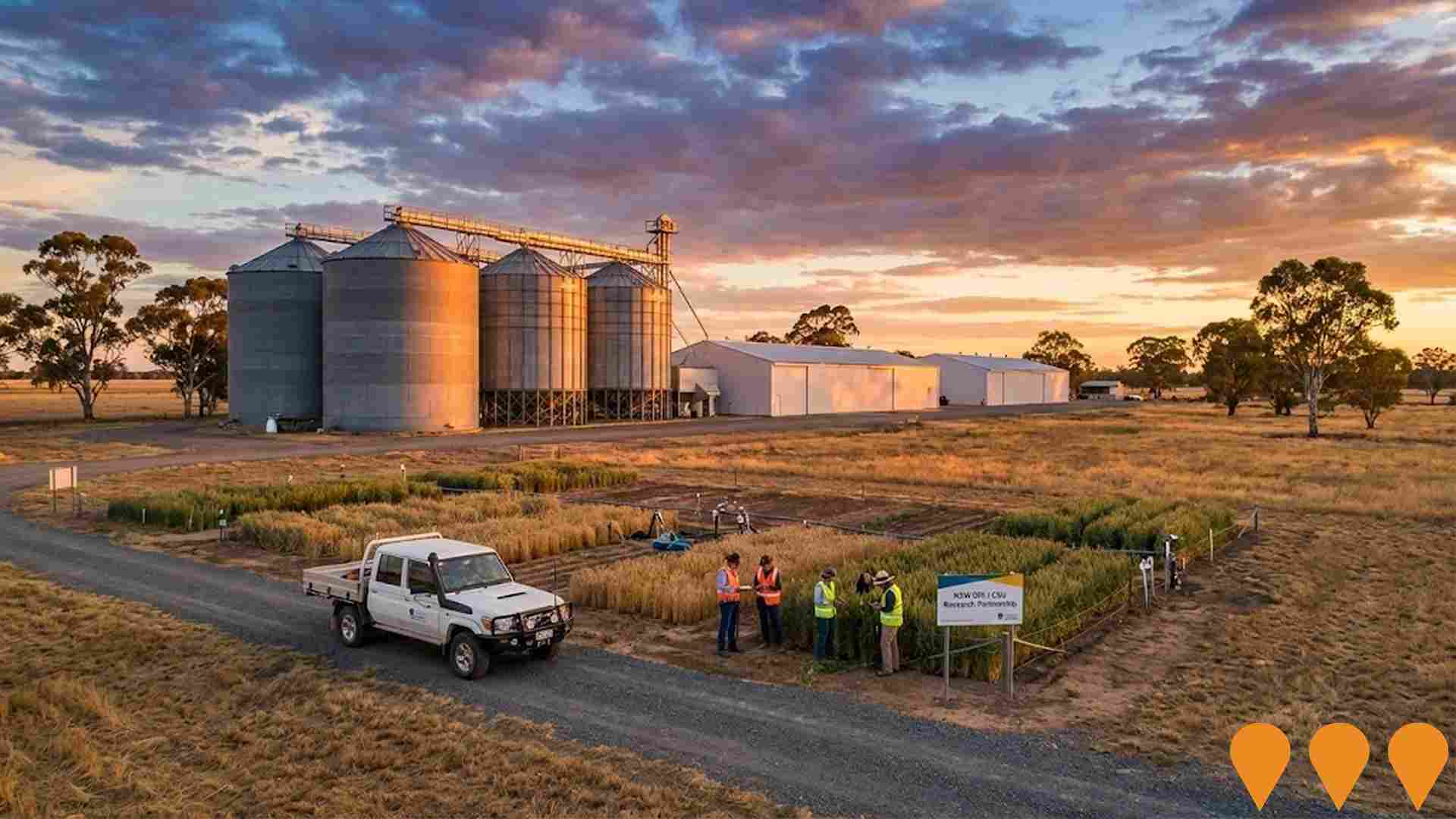
Deniliquin Hospital Redevelopment
Comprehensive redevelopment of Deniliquin Hospital including new emergency department, surgical suites, and patient accommodation. Will serve as the primary healthcare facility for the southern Riverina region.

Deniliquin NBN Upgrade
Fiber-to-the-premises upgrade for Deniliquin and surrounding rural areas. Part of the regional connectivity initiative to provide high-speed internet access to support digital agriculture and remote work capabilities.

Employment
Deniliquin shows employment indicators that trail behind approximately 70% of regions assessed across Australia
Deniliquin has a balanced workforce with white and blue collar jobs, prominent essential services sectors, an unemployment rate of 4.9% as of June 2025, and estimated employment growth of 4.6% over the past year. The unemployment rate is 1.2% higher than Rest of NSW's rate of 3.7%, with workforce participation at 53.9%.
Leading industries are health care & social assistance, retail trade, and education & training. Agriculture, forestry & fishing shows strong specialization, employing 1.5 times the regional average, while mining employs only 0.1% of local workers compared to Rest of NSW's 2.5%. Many residents commute elsewhere for work based on Census data. Over June 2024 to June 2025, employment increased by 4.6%, labour force by 4.4%, reducing the unemployment rate by 0.2 percentage points.
In contrast, Rest of NSW saw employment contraction of 0.1% and unemployment rise by 0.4%. National employment forecasts from Jobs and Skills Australia (May 2025) suggest Deniliquin's employment could grow approximately 6.3% over five years and 13.3% over ten years, based on industry-specific projections applied to its current mix.
Frequently Asked Questions - Employment
Income
Income figures position the area below 75% of locations analysed nationally by AreaSearch
Deniliquin's median taxpayer income was $45,539 and average was $52,725 in financial year 2022. This is lower than the national averages of $51,686 median and $67,042 average for that year. The Rest of NSW had a higher median income at $49,459 and an average of $62,998 in 2022. By September 2025, estimated incomes would be approximately $51,281 median and $59,374 average based on Wage Price Index growth since financial year 2022. Census data shows Deniliquin's household, family, and personal incomes fall between the 13th to 26th percentiles nationally. Income distribution indicates that 27.3% of Deniliquin residents (1,981 individuals) earn within the $1,500 - $2,999 range, similar to the broader regional trend of 29.9%. Despite modest housing costs allowing for 88.4% income retention, total disposable income ranks at only the 18th percentile nationally.
Frequently Asked Questions - Income
Housing
Deniliquin is characterized by a predominantly suburban housing profile, with a higher proportion of rental properties than the broader region
Deniliquin's dwelling structure, as per the latest Census, comprised 89.1% houses and 11.0% other dwellings (semi-detached, apartments, 'other' dwellings). Non-Metro NSW had 89.8% houses and 10.2% other dwellings. Home ownership in Deniliquin was 42.0%, with mortgaged dwellings at 30.4% and rented ones at 27.6%. The median monthly mortgage repayment was $1,083, lower than Non-Metro NSW's average of $1,285. Median weekly rent in Deniliquin was $230, compared to Non-Metro NSW's $235. Nationally, Deniliquin's mortgage repayments were significantly lower at $1,083 versus Australia's average of $1,863, and rents were substantially below the national figure of $375.
Frequently Asked Questions - Housing
Household Composition
Deniliquin features high concentrations of lone person households, with a lower-than-average median household size
Family households constitute 62.4% of all households, including 20.8% couples with children, 31.0% couples without children, and 9.6% single parent families. Non-family households account for the remaining 37.6%, with lone person households at 35.0% and group households comprising 2.5% of the total. The median household size is 2.2 people, which is smaller than the Rest of NSW average of 2.3.
Frequently Asked Questions - Households
Local Schools & Education
Deniliquin faces educational challenges, with performance metrics placing it in the bottom quartile of areas assessed nationally
The area's university qualification rate is 15.1%, significantly lower than NSW's average of 32.2%. Bachelor degrees are the most common at 10.8%, followed by postgraduate qualifications (2.2%) and graduate diplomas (2.1%). Vocational credentials are prevalent, with 39.6% of residents aged 15+ holding them, including advanced diplomas (9.6%) and certificates (30.0%). Educational participation is high at 27.9%, comprising 10.5% in primary, 8.4% in secondary, and 2.3% in tertiary education.
Deniliquin has a robust network of 7 schools educating approximately 1,144 students, with typical Australian school conditions (ICSEA: 958) and balanced educational opportunities. The schools include 4 primary, 2 secondary, and 1 K-12 school. The area functions as an education hub with 16.0 school places per 100 residents, attracting students from surrounding communities. Note: where schools show 'n/a' for enrolments, please refer to the parent campus.
Frequently Asked Questions - Education
Schools Detail
Nearby Services & Amenities
Transport
Transport servicing is low compared to other areas nationally based on assessment of service frequency, route connectivity and accessibility
Transport analysis in Deniliquin shows 63 active public transport stops operating within the area. These stops service a mix of bus routes, totaling 38 individual routes. Collectively, these routes provide 347 weekly passenger trips.
The accessibility of transport is rated as good, with residents typically located 297 meters from the nearest transport stop. Service frequency averages 49 trips per day across all routes, equating to approximately 5 weekly trips per individual stop.
Frequently Asked Questions - Transport
Transport Stops Detail
Health
Health performance in Deniliquin is well below average with prevalence of common health conditions notable across both younger and older age cohorts
Health data indicates significant challenges for Deniliquin, with common health conditions prevalent among both younger and older age groups. Private health cover is low, at approximately 47% (around 3,389 people), compared to the national average of 55.3%.
The most frequent medical conditions are arthritis and mental health issues, affecting 11.5% and 9.3% of residents respectively. However, 59.5% claim to be free from medical ailments, slightly lower than the Rest of NSW's 60.6%. Deniliquin has 27.6% (around 2,004 people) aged 65 and over, which is lower than Rest of NSW's 30.5%.
Frequently Asked Questions - Health
Cultural Diversity
The latest Census data sees Deniliquin placing among the least culturally diverse areas in the country when compared across a range of language and cultural background related metrics
Deniliquin's cultural diversity was found to be below average, with 88.0% of its population being citizens, 93.3% born in Australia, and 96.5% speaking English only at home. Christianity is the predominant religion in Deniliquin, comprising 56.7% of people, compared to 58.1% across Rest of NSW. The top three ancestry groups are Australian (35.2%), English (31.5%), and Irish (8.8%).
Notably, Australian Aboriginal representation is higher at 4.1% in Deniliquin compared to the regional average of 2.5%. Scottish representation is also slightly lower at 8.5%, versus 9.2% regionally, while Maori representation is higher at 0.5% compared to the regional figure of 0.2%.
Frequently Asked Questions - Diversity
Age
Deniliquin hosts an older demographic, ranking in the top quartile nationwide
Deniliquin's median age at 47 years is significantly higher than the Rest of NSW average of 43 years and exceeds the national average of 38 years. The age profile shows that those aged 65-74 are particularly prominent, making up 14.8% of the population, which is higher than both the Rest of NSW figure (12.5%) and the national average (9.4%). Meanwhile, the 35-44 age group comprises only 9.4%, lower than the Rest of NSW percentage (10.7%). Between 2021 and present, the 15 to 24 age group has increased from 10.7% to 11.9%, while the 25 to 34 cohort has risen from 10.2% to 11.4%. Conversely, the 45 to 54 age group has decreased from 11.8% to 9.8%, and the 5 to 14 age group has fallen from 11.6% to 10.3%. By 2041, Deniliquin's population is projected to shift significantly in terms of age composition. The 75 to 84 age group is expected to grow by 30%, reaching a total of 837 people from the current figure of 643. This growth will be led by those aged 65 and above, who are projected to comprise 73% of Deniliquin's population growth between now and 2041. Conversely, population declines are projected for the 35 to 44 age group and the 0 to 4 age cohort.
